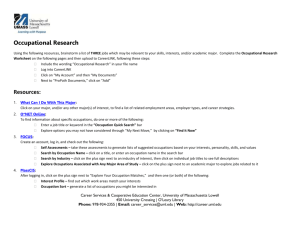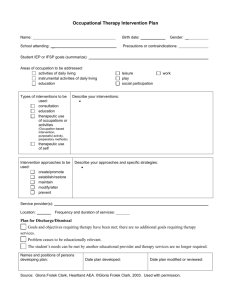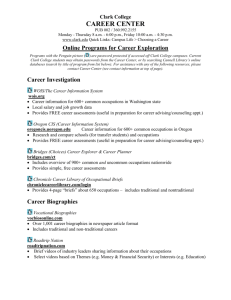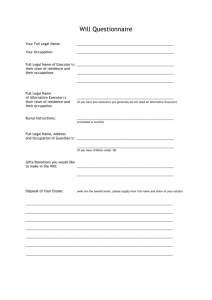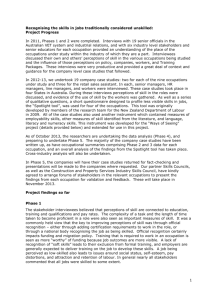This guideline presents a six-step procedure for the preparation of
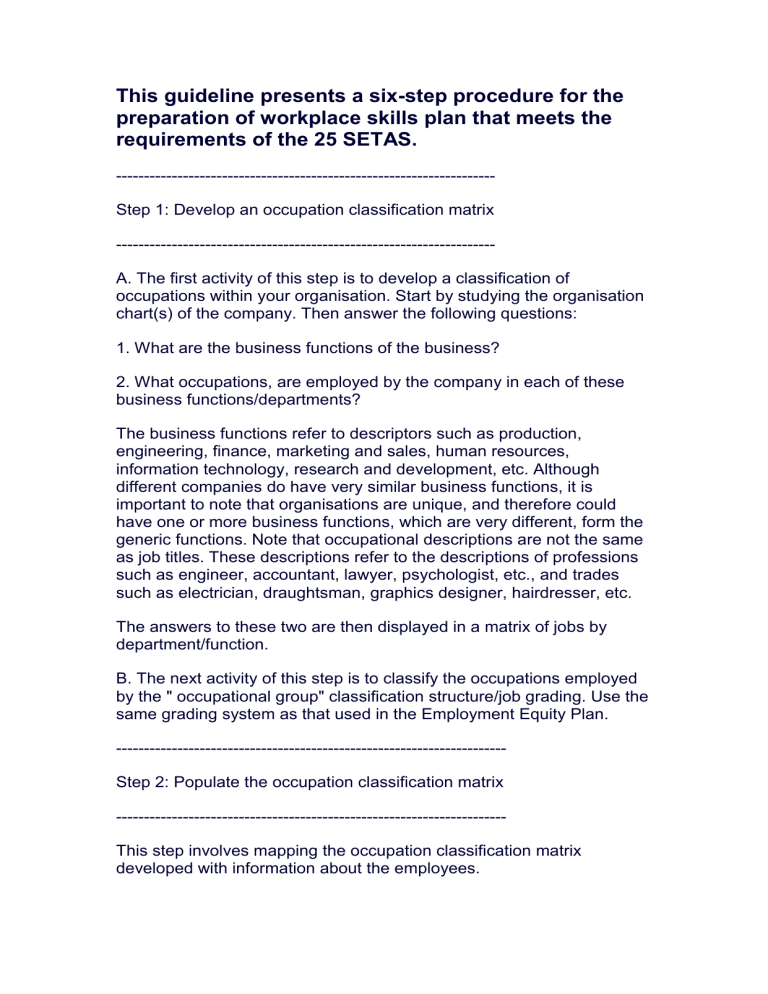
This guideline presents a six-step procedure for the preparation of workplace skills plan that meets the requirements of the 25 SETAS.
--------------------------------------------------------------------
Step 1: Develop an occupation classification matrix
--------------------------------------------------------------------
A. The first activity of this step is to develop a classification of occupations within your organisation. Start by studying the organisation chart(s) of the company. Then answer the following questions:
1. What are the business functions of the business?
2. What occupations, are employed by the company in each of these business functions/departments?
The business functions refer to descriptors such as production, engineering, finance, marketing and sales, human resources, information technology, research and development, etc. Although different companies do have very similar business functions, it is important to note that organisations are unique, and therefore could have one or more business functions, which are very different, form the generic functions. Note that occupational descriptions are not the same as job titles. These descriptions refer to the descriptions of professions such as engineer, accountant, lawyer, psychologist, etc., and trades such as electrician, draughtsman, graphics designer, hairdresser, etc.
The answers to these two are then displayed in a matrix of jobs by department/function.
B. The next activity of this step is to classify the occupations employed by the " occupational group" classification structure/job grading. Use the same grading system as that used in the Employment Equity Plan.
----------------------------------------------------------------------
Step 2: Populate the occupation classification matrix
----------------------------------------------------------------------
This step involves mapping the occupation classification matrix developed with information about the employees.
This include the following:
1. Number of employees for each of the occupations in the occupation matrix.
2. Number of employees for each of the occupations in the matrix that received training in a particular historic time period.
3. Number of vacancies for each of the occupations in the occupation matrix.
4. Number of employees for each of the occupations in the matrix that will receive training in a particular future time period.
Demographic data include the following:
1. Breakdown of the number of employees for each of the occupations in the occupation matrix by race group.
2. Breakdown of the number of employees for each of the occupations in the occupation matrix by gender.
3. Breakdown of the number of employees for each of the occupations in the occupation matrix by age.
4. Breakdown of the number of employees for each of the occupation in the occupation matrix by length of service.
-------------------------------------------------------------------------------
Step 3: Establish the company’s skills development priorities
-------------------------------------------------------------------------------
This step involves identifying specific skills development needs in the context of your company’s strategic business priorities. The strategic business priorities will usually be found in the company’s strategic business plan.
These priorities originate from an analysis of the opportunities and threats in your company’s external business environment and the strengths and weaknesses in its internal business environment.
To establish the organisation's skills development priorities, the strategic business priorities need to be investigated in search of answers to the following six key questions:
1. KNOW-HOW: Which of the strategic business priorities require "know how" that does not currently exist within the organisation and therefore needs to be acquired?
2. UP-SKILLING: Which of the strategic business priorities imply new technologies and more sophisticated working methods that will require particular "up-skilling" of certain employees?
3. RE-SKILLING" Which of the strategic business priorities imply staff redeployment to different jobs and different kinds of work that will require "re-skilling" of certain employees?
4. MULTI-SKILLING" Which of the strategic business priorities implies upgrading of lower level employees that will require "multi-skilling" of the affected employees?
5. REFRESHER TRAINING: Which of the strategic business priorities imply reinforcement of current business practices that will require
"refresher training" of current employees?
6. INITIAL TRAINING: Which of the strategic business priorities imply business expansion that will require "initial training" of new employees?
~
Having established clear-cut answers to these questions, the next step is to define the following:
1. The occupations in the occupation classification matrix that will be targeted for:
# Acquiring the "know how" that does not currently exist within the organisation
# Employees who will require "up-skilling"; "re-skilling"; "multi-skilling";
"refresher training", and "initial training".
2. The particular training that will be provided to incumbents of the identified occupations in terms of the requirements of the related strategic business priorities; and
3. The number of incumbents occupying the identified occupations that will receive the identified training.
SETAS also require the following information:
1. A description of vacancies the organisation was not able to fill in the previous SETA financial year.
2. A description of the occupations relating to these vacancies.
3. A description of vacancies the organisation plans to fill in the new
(succeeding) SETA financial year.
4. A description of the occupations relating to these vacancies.
---------------------------------------------------------------------------
Step 4: Define the education and training required for achieving the strategic skills development priorities
---------------------------------------------------------------------------
The next step is to specify the education and training required for achieving the organisation's strategic skills development priorities.
To do this, first produce a table with the following columns:
1. Column 1: Occupational Group
2. Column 2: Occupation
3. Column 3: Development Purpose
4. Column 4: Education and Training Required
Next, populate the rows of Column 1 with the "occupational group" classification structure outlined in steps 1 and 2.
Next, populate the rows of Column 2 with the related occupations that were identified for a particular business function of the organisation.
Then, note the appropriate strategic development purpose, i.e. to acquire new skills, to up-skill, to multi-skill, etc., where and as applicable, in the rows of Column 3.Conclude, by defining the particular type of education and/ or training that will be required in terms of the purpose noted in Column 3, in Column 4.
The next activity will be to:
1. Specify how many employees will receive planned education and training inputs.
2. Indicate if the envisaged education or training will be provided inhouse or by external training suppliers.
3. Indicate whether the training will be formal or informal.
4. Indicate what the expected total cost will be for the envisaged inhouse and external training.
Step 5: Define the number and characteristics of training beneficiaries that will be trained in the Levy-Grant Year
This step basically requires the population of demographic data, i.e. a breakdown of the total number of employees (training beneficiaries) that will be trained in each occupational group by race and gender.
SETAS also require the following information:
1. The number of training beneficiaries that are likely to be persons with disabilities.
2. The nature of difficulties being anticipated in undertaking the planned education and training.
----------------------------------------------------------------------
Step 6: Define the quality assurance measures for each of the planned education and training activities
-----------------------------------------------------------------------
In this step you are required to describe the quality assurance measure(s) that will be used for each of the planned education and training activities. Quality assurance in this context refers to the provision of answers to the following two crucial questions:
1. How will be assured that the education and training courses selected, will actually train the knowledge, skills and competences required by the organisation?
2. How will be assured that employees enrolled for the education and/ or training (the beneficiaries of education and training) could be awarded credits for their learning towards a nationally recognised qualification, e.g. a qualification registered on the NQF?
Answers to these questions relate to issues including, but not limited to:
> The relationship (linkage) between the contents of education and training programmes selected and the requirements of related NQF Unit
Standards
> The registration and accreditation of these education and training programmes with the ETQAs of SETAS
> The registration of the providers of these education and training programmes
> The registration of the teachers, trainers and facilitators of these training programmes as qualified ETD practitioners.
* Based on Ernst, E: A Handbook For Ernst, E. Skills development:
Handbook for SETAS, employers, employees In South Africa College for competence, Pretoria, 2000


